Last summer, the New Museum of Contemporary Art announced its plan to launch a new triennial, touting it as New York’s first international exhibition dedicated to emerging artists. The inaugural exhibition, which closed in July 2009, focused on artists belonging to Generation Y (those born around 1980). Relying on the help of 150 colleagues or “informers” from around the world, The Generational: Younger Than Jesus aimed to “compose the Facebook of a new generation”–it not only focused on Facebook’s principal audience but also was organized according to its logic.1 While the New Museum didn’t jettison the curator altogether, the decentralization of this curatorial effort points to a more far-reaching cultural shift in the relationship between producer and consumer. As Clay Shirky, who writes about the Internet, put it in 1999, “There are no more consumers, because in a world where an email address constitutes a media channel, we are all producers now.”2 A decade later, with the advent of YouTube, Facebook, and Wikipedia, we have only moved further in this direction. Meanwhile, “curating” is a term that has been used to describe both the self-fashioning that occurs on Facebook and the function of news aggregators like The Daily Beast and The Huffington Post.3
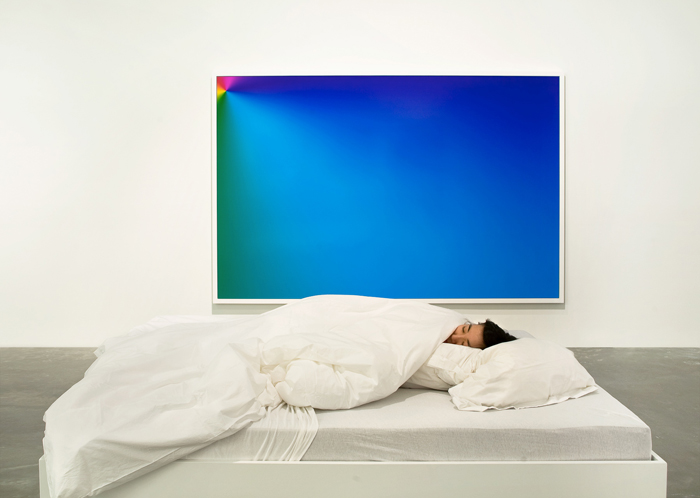
On wall: Cory Arcangel, Photoshop CS: 72 by 110 inches, 300 DPI, RGB, square pixels, default gradient “Spectrum”, mousedown y=1416 x=1000, mouse up y=208 x=42, 2009. Unique chromogenic print, 110 x 72 in. Courtesy the artist and Team Gallery, New York. On floor: Chu Yun, This is XX, 2006. Female participant, sleeping pill, and bed. Dimensions variable. La Gaia Collection, Busca, Italy. Photo: Benoit Pailley.
But, as Cory Arcangel asked in a recent interview, “Where is art left when everyone is a producer?” (or when curating is done by crowdsourcing, the method used to construct Wikipedia, and exhibitions become another form of Facebook?)4 The practice of consulting colleagues to organize an exhibition, particularly one of this scope, is certainly not new; nor is a show that focuses on emerging artists.5 In this case, however, it’s not a generation of artists but the generation to which the artists (and everyone else in this demographic) belong that is the real focus, which not only signals an acknowledgment of what might now be called– without irony–the “tradition” of pluralism but also suggests that the show’s generating principle might have broader implications.
Writing in 1934, Walter Benjamin argued that,”[O]nly by transcending the specialization in the process of production…can one make the production politically useful; and the barriers imposed by specialization must be breached jointly by the productive forces that they were set up to divide.” For Benjamin, the “functional transformation of the apparatus” was a measure of its ability “to turn [consumers] into producers–that is, readers or spectators into collaborators.”6 In a deceptively similar formulation, Jonah Peretti, one of the founders of The Huffington Post, argues that news is not something handed down from above but “a shared enterprise between its producer and its consumer.”7 Of course “politically useful production” is not HuffPo‘s objective–at least not in the way Benjamin construed it–but Peretti shares a belief in the critical potential of this collaboration.
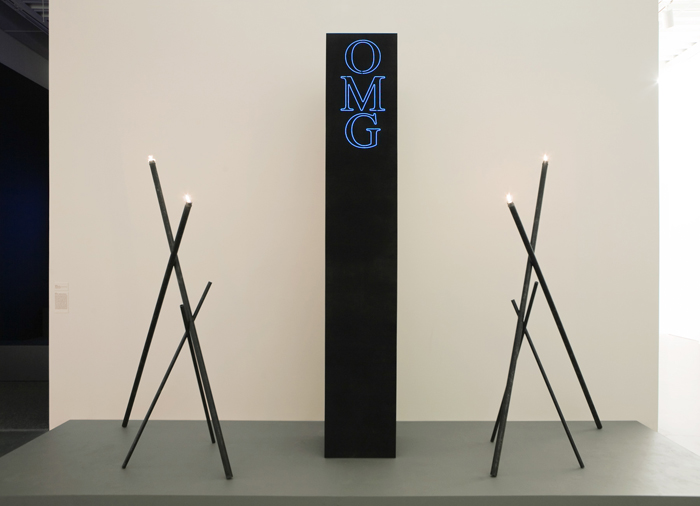
AIDS-3D, OMG Obelisk, 2007. MDF, electroluminescent wire, steel, hot glue, acrylic paint and fire; 118 x 1/2 x 23 5/8 in. Photo: Benoit Pailley.
In the art world the collaborative impulse–implicit in minimalism, incipient in postminimalism and conceptual art–became fully fledged with the advent of relational aesthetics in the early ’90s. An important difference between the art practices of the ’60s and current practices is not just that the object of art has changed but that the subject of art has changed. The prevailing if not dominant art form for at least fifteen years, installation art seemed to be the perfect correlative for the decentered, fragmented subject of postmodernism. Working with this widely accepted understanding of postmodern subjectivity, a number of writers have attempted to rethink the relationship between the individual and society without ruling out the potential for (political) agency.8 Jacques Ranciere’s writings on art and politics have contributed to this debate.
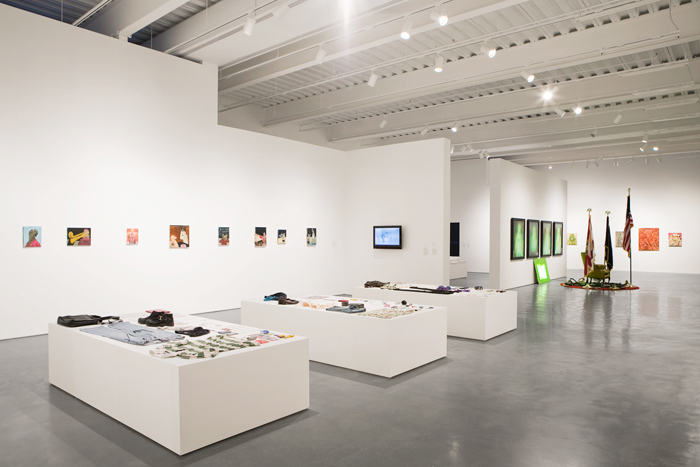
The Generational: Younger Than Jesus, 2009. Installation view of the second floor, including works by Tala Madani, Liu Chuang, Stephen G. Rhodes, and Jakub Julian Ziolkowski, New Museum of Contemporary Art, New York. Photo: Benoit Pailley.
In The Ignorant Schoolmaster, Ranciere tells the story of Joseph Jacotot, an eighteenth-century educator who argued that, “an ignorant person could teach another ignorant person what he did not know himself, proclaiming the equality of intelligences, and calling for intellectual emancipation against the received wisdom concerning the instruction of the lower classes.”9 The problem with traditional pedagogy was that explication established, and continued to reinforce, a division between an inferior and a superior intelligence:”To explain something to someone is first of all to show him he cannot understand it by himself.”10 The student, having internalized this inference, was forever doomed to a subordinate position (or at least to feeling subordinate), following in the master’s footsteps without any hope of ever catching up. Jacotot understood that, while there might be different manifestations of intelligence, intellectual capacity was universal. “Emancipation,” writes Ranciere, “is becoming conscious of this equality of nature.”11 If inequality was for Jacotot a structural condition of the master/student dyad, eliminating it would require a different kind of instruction–one that could “reveal an intelligence to itself.”12 Learning just one thing provided a foundation, a point of reference to which everything else could be related.
Ranciere, following Jacotot, writes that,”Understanding is never more than translating, that is, giving the equivalent of a text, but in no way its reason.”13 And, because interpretation is required to “give the equivalent of a text,” translation is a kind of auto-explication. “Thus, each one of us describes our parabola around the truth. No two orbits are alike. And this is why the explicators endanger our revolution.”14 Learning is an individual affair because this is the basis of equality: “there is no equality except between men, that is to say, between individuals…The citizen, on the contrary, the inhabitant of the political fiction, is man fallen into the land of inequality.”15 Jacotot’s approach clearly didn’t involve “teaching” in the usual sense but, rather, a form of instruction that was essentially autodidactic, which was the only way to prevent the formation of a hierarchy between the teacher and the taught.
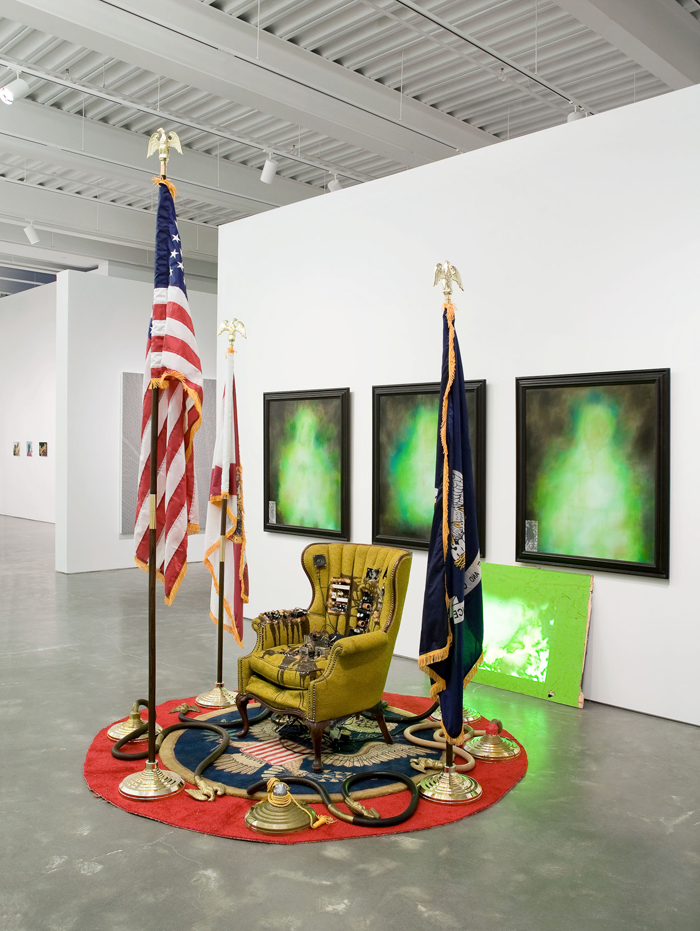
Stephen G. Rhodes, Interregnum Repetition Restoration (Upholstered), 2008. Chair, speakers, electrical components, fabric, resin, presidential seal carpet, wooden flagpoles, flags, painted plywood, and video; approx. 9 x 6 1/2 x 7 1/2 ft. Duration: 2 min. Private collection; courtesy Overduin and Kite, Los Angeles. Photo: Benoit Pailley.
In his 2004 lecture “The Emancipated Spectator,” published in Artforum in 2007, Ranciere takes up Jacotot’s theory of emancipation in a discussion of theater, specifically, and spectatorship more generally. In an accompanying interview he said, “An art is emancipated and emancipating when it renounces the authority of the imposed message, the target audience, and the universal mode of explicating the world, when, in other words, it stops wanting to emancipate us.”16 Insisting that there is “no subversive form of art in and of itself,” he argues that a whole host of time-honored critical tropes, starting with Brechtian distanciation, have not only been exhausted but were factitious to begin with.17 The persistent belief in the need to activate the viewer, along with the collective nature of that activation, perpetuates the idea that passivity–like the inferiority of the ignorant person’s intelligence–is fundamental to the spectator, a fiction that has now become naturalized. Ranciere’s aim, however, is not to drive a stake through the heart of criticality; on the contrary, he is concerned to challenge a misplaced faith in the viability of what are now conventional–and demonstrably failed–strategies. Getting rid of both the nostalgia for a utopian future and the assumption of the viewer’s need to be incited to action (which have occluded the emancipatory potential of contemporary art) opens up possibilities for critique in the present.
“For me,” Ranciere writes, “the fundamental question is to explore the possibility of maintaining spaces of play. To discover how to produce forms for the presentation of objects, forms for the organization of spaces, that thwart expectations. The main enemy of artistic creativity as well as of political creativity is consensus–that is, inscription within given roles, possibilities, and competences.”18 The reference to play suggests a connection to Roland Barthes and Situationism, at least in more recent memory, but for Ranciere it goes back further, to Immanuel Kant and Friedrich Schiller. Nonetheless, it doesn’t take us very far off the path from Bertolt Brecht and Benjamin, whose particular forms of disruption have simply come to represent the consensus. Interpreting the world, Ranciere argues, is “already a means of transforming it” and translation allows spectators to “tell their own stories” about what they encounter. “[I]n a theater, or in front of a performance, just as in a museum, at a school, or on the street, there are only individuals, weaving their own way through the forest of words, acts, and things that stand in front of them or around them. The collective power that is common to these spectators…is the power to translate in their own way what they are looking at.”19 Maintaining spaces of play requires new forms on the one hand and new spectators on the other, but the artist’s forms and the spectator’s interpretation aren’t in dialogue. “The work of dissensus,” according to Ranciere, “is to always reexamine the boundaries between what is supposed to be normal and what is supposed to be subversive,” and critique involves “a multiplicity of small ruptures, of small shifts, that refuse the blackmail of radical subversion.”20 But doesn’t this amount to replacing subversion with the subversion of normative subversity, or a kind of negative dialectics (writ small in this case)? If translation is “giving the equivalent of a text, but in no way its reason” and collective power is an aggregate of individual interpretations, equality (and emancipation) appears to leave out the possibility of shared meaning, either between the artist and the spectator or among spectators, leaving us with so many “parabolas around the truth.”
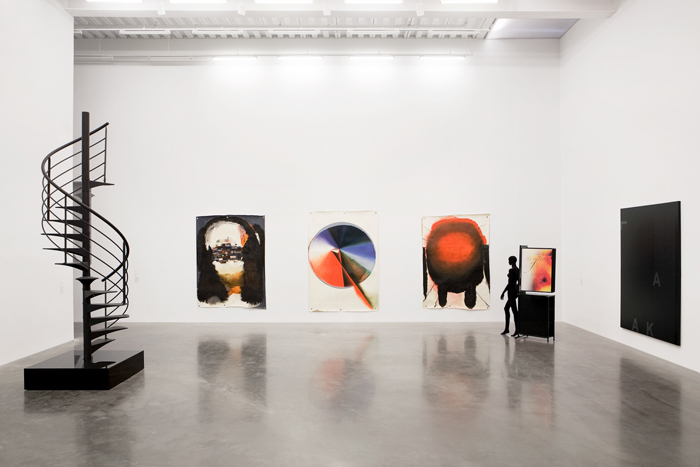
The Generational: Younger Than Jesus, 2009. Installation view of the fourth floor, including works by Loris Gréaud, Kerstin Brätsch, Das Institut (Brätsch and Adele Röder) and Adam Pendleton, New Museum of Contemporary Art, New York. Photo: Benoit Pailley.
Ranciere’s critique of consensus can be seen as an effort to make a virtue out of the necessity that is pluralism by offering a way out of the endgame of post-criticality.21 Presenting a plausible argument for criticality under current conditions, without relying on some version of an avant-gardism that doesn’t–and can’t–prevail, is arguably a feat in itself. It’s hard to argue with the claim that the sign of activation has become reified, but this doesn’t answer the question of what kind of emancipation a pluralism of critique–as opposed to something like a pluralist critique–can offer. Criticality, following Ranciere’s logic, is in the eye of the beholder; it’s not produced by the artist or the work–in fact, whatever critique the work might containwould presumably constitute an “imposed message”– but consumed (or pro-sumed) by the spectator. Rupture, replaced by a “multiplicity of ruptures,” is itself ruptured, or decentered, but we have to ask whether its critical potential is undercut (if not vitiated) by the fact that subversion becomes, in essence, “customized.” Moreover, if critique is a matter of reception, where does that leave the work? Or, as Paul Chan put it in an acknowledgment of his debt to Ranciere published in the same issue of Artforum, “How do we test the work so that we know it is something made that has become more than something simply made?”22
While it hasn’t disappeared, relational aesthetics has more or less run its course, and Unmonumental, the New Museum’s inaugural exhibition when it reopened in 2007, registered the impact of the re-emergence of sculpture–or “the object”–after its prolonged subordination to installation art. But sculpture’s return, like the return of painting in the wake of conceptual art, could hardly be described as triumphal. As Massimiliano Gioni wrote in his catalog essay, “[T]his first decade of the twenty-first century produced a sculpture of fragments, a debased, precarious, trembling form.”23 There wasn’t a great deal of “unmonumental” sculpture in the Younger than Jesus show, that moment perhaps having passed. Instead, it included work in a wide range of mediums–including video, installation, painting, performance, and some less insecure sculpture–much of which, despite its traditional medium, was informed by the relationality of recent practices.
Kerstin Braetsch, a member of the artists’ collective Das Institut–described in a recent press release as an “import-export agency”–said in an interview that she and co-founder Adele Roeder often collaborate on computer-generated images that “can become anything.”24 Braetsch integrates them into her paintings, several of which were included in Younger than Jesus; Roeder transfers them onto fabrics, which can, in turn, be used by others. (For instance, another artist used stockings Roeder produced in a performance.) Not only do the images have more than one “author” but they’re also incorporated into more than one work–and more than one kind of work. How these artists decide how they are used and by whom is an open question, but there would appear to be little or no proprietary interest in the images themselves. Like the work of art “designed for reproducibility,” these images are not created to be used so much as appropriated.25 Since they have multiple contexts to begin with, they are always already recontextualized, their production a form of viral consumption. Braetsch’s paintings might be unique artworks, but they remain interconnected with others’ work: as she says, “I see my paintings in relation to something else.”26
The participatory aspect of this relational work is shifted to its production, and even work as “finished” as painting tends to remain open-ended, although much less so (and less explicitly) than in relational aesthetics. It’s not just that the work’s meaning isn’t fixed; it’s that the work itself isn’t fixed. “Relational” not only applies to the work’s reception or consumption, but also is a constitutive feature of what might be described as a kind of collective bricolage. And, just as Braetsch and Roeder’s images are produced for appropriation, the work itself seems to be made for appropriation–that is, for translation. Laura Hoptman understands the heterogeneity of the work in Younger than Jesus as evidence of a “post-medium attitude,” by which she means, I think, that not only do the artists not feel constrained to work in a particular medium but many, if not most, work in just about every medium, in addition to participating in performances and engaging in other ephemeral modes of production.27 It makes more sense to consider individual works in relation to the artist’s larger project, which is constantly being updated, like a Facebook page or a Twitter feed. Many of the artists in this show were, or have been, members of a collective (or several) and many work collaboratively.As a number of critics have pointed out, perennial claims for the inherent criticality of collaboration have not only made the claim itself conventional (i.e. the consensus), but, like similar claims for the activation of the viewer, it’s based on an erroneous assumption.28 And relationality rather than criticality seems to be the goal for many of these artists in any case.
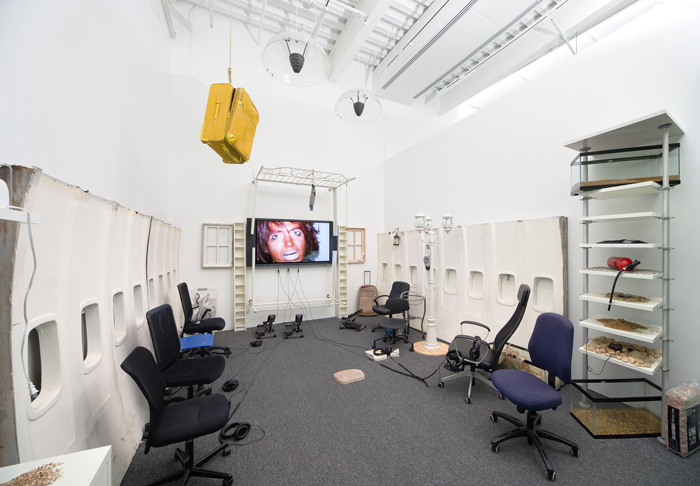
Ryan Trecartin, installation view from The Generational: Younger Than Jesus, New Museum of Contemporary Art, New York. Courtesy the artist and Elizabeth Dee, New York. Photo: Benoit Pailley.
Reviewing Younger than Jesus, Jerry Saltz was ecstatic about the artists’ interest in the world around them: “They’re investigating the whole world, not just the art world.” Of course, this shift was as important for what it excluded as for what it included: “The show suggests that ideas about culture, ethnography, anthropology, and sociology, YouTube and Facebook, and science and documentary film have all become more important than October magazine postmodernism. Sociology is the new black.”29 The implication–and the cause for Saltz’s celebration–is that the work no longer answers to the critical (or historical) imperativesthat the “post” in (October) postmodernism refers to. As Pierre Bourdieu put it: “[I]n an artistic field which has reached an advanced stage of [its] history…the history is immanent to the functioning of the field, and to meet the objective demands it implies, as a producer but also as a consumer, one has to possess the whole history of the field.”30 Being visual art, the work, in Saltz’s view, shouldn’t need to be read–only seen– and its sociological bent suggests that the artists no longer feel compelled to “meet the objective demands” of the artistic field. (This might have been true for some time now, but Younger than Jesus appears to have proven it definitively.) Trading its self-referentiality for referential- ity–to life, to the world–this work has supposedly thrown off the yoke of, well, art. (Saltz would say art theory.)
For Saltz, the show was evidence of the liberation, even the rebirth, of art. But we might ask what it’s being reborn as. For all his enthusiasm, he isn’t very specific about what the work might offer other than its difference from its theoretically-beholden predecessors –except for its demonstration that “the sublime has moved into us, that we are now the sublime; life, not art, has become so real that it’s almost unreal.”31 I’m not sure whose life Saltz is referring to, but I would argue that life isn’t becoming more real but, rather, more virtual by the minute–from Facebook and Twitter to parasocial relationships and Second Life–and that, if the sublime is indeed resurfacing, it’s in the virtual realm that we’re more likely to find it. Added to, and further complicating, the split subjectivity of postmodernism is the self-constructed, or “curated,” self of this socially networked age.

Ryan Trecartin, composite image from Sibling Topics (Section A and Section B), 2009. Single-channel video installation. sets and installation in collaboration with Lizzie Fitch. Courtesy the artist and Elizabeth Dee, New York.
“Identity was initially related to social identity,” Glenn Ligon said in a recent roundtable discussion, “and now identity is about performance, and everyone can perform it… I’m very confused now when I talk to young artists because I don’t know what they’re anchored to, except to the idea of performance itself.”32 Ryan Trecartin is one of the artists in Younger than Jesus whose work engages the question of identity performance –or, more precisely, the inability to perform it. The hyperactive, hyper-real, constantly morphing “characters” in his videos (whose rapid cuts, manic pace, and multiple insets render them simultaneously mesmerizing and unwatchable) are so unstable that they’re barely “identifiable.” Trecartin himself appears in numerous guises, never–and always–(as) himself. But even those whose work doesn’t deal with identity are performing it (that age-old fact of being an artist). As Harold Rosenberg put it, “An artist is a person who has invented an artist.”33 Ligon alludes to the possibility that, right now, the focus isn’t on inventing artists but on performing artistic identity (different “translations” of the same identity rather than the invention of different identities), which shouldn’t come as a surprise, given the widespread performance of identity on Facebook and other social networking sites.
This is not to say that these artists or anyone else belonging to this generation have become so “internet- worked” that they no longer live in the real world. “[For] people in their 20s who were in college when Facebook appeared and have never lived as adults without online awareness,” writes Clive Thompson in an article that was reprinted in the Younger than Jesus catalog, “participation isn’t optional. If you don’t dive in, other people will define who you are. So you constantly stream your pictures, your thoughts, your relationship status and what you’re doing–right now!–if only to ensure the virtual version of you is accurate, or at least the one you want to present to the world.”34 While this scenario might be accurate in some cases, it’s certainly not true for everyone under 30 (or 33). However, it’s also clear that changes in social media over the last few years pose a whole new set of questions for art practice and discourse. Lev Manovich asked recently whether art after Web 2.0 (web applications developed roughly 10 years ago that allow interactive information sharing) was still possible–or, he wondered, does this technology “make professional art irrelevant?” He goes on to ask, “[C]an professional art survive the extreme democratization of media production and access?”35 That he is impelled to qualify the term “art” in this way raises an important issue.
Even as he argues that an artistic field at an advanced stage is constituted by producers and consumers who have some kind of (professional) knowledge of the field’s history, Bourdieu acknowledges that, “There is no other criterion of membership of a field than the objective fact of producing effects within it.”36 This is precisely Saltz’s point–that the history of the field is not required reading to participate in it–which is identical to the argument that has been offered in defense of the “citizen journalist” (the non-professional who gets the scoop).37 And, while the shift from modernism to postmodernism witnessed the artist’s de-skilling, current practices point to, or anticipate, a kind of de- professionalization–homologous to Anton Ehrenzweig’s dedifferentiation–of the artist. “What is common to all examples of dedifferentiation,” writes Ehrenzweig, “is their freedom from having to make a choice. While the conscious gestalt principle enforces the selection of a definite gestalt as a figure, multi-dimensional attention… can embrace both figure and ground.”38 The conscious gestalt involves the isolation–or differentiation–of figure and ground, but multi-dimensional attention doesn’t require this distinction. This is what I take Ranciere to mean when he says, “[C]ontemporary art is, quintessentially, art defined by the erasure of medium specificity, indeed by the erasure of the visibility ofart as a distinct practice.”39 He can still refer to “contemporary art” even as he denies its “visibility”– that is, he doesn’t distinguish it as a figure against the ground of what he calls the “distribution of the visible” or the “distribution of the sensible.”40
Arcangel addresses this issue as well: “I only come to art from the Internet; what I am doing still comes from general online culture. And lately I have felt that some of these clever projects work best online and shouldn’t appear in the art context. They work better when open to a live audience online.” (Again, it would be interesting to find out what he thinks they work better as.) Arcangel, for now at least, has two distinct audiences, since his online projects aren’t typically legible (or visible) to an art audience and vice versa. But if Saltz’s assessment bears out, information–about ethnology, YouTube, documentary film, etc.–will increasingly be substituted for knowledge, making it much more likely that, as a younger, more technologically savvy audience (or generation) emerges, the boundary between these two audiences will begin to dissolve. One of Facebook’s principal tenets is: “People should have the freedom to share whatever information they want” with the understanding that “more information makes a better world, and a more tolerant one.”41 But more information doesn’t necessarily make us more informed. “[T]he Internet,” Arcangel says, “is full of half-truths; you can find a ‘factual basis’ for anything. With things like Wikipedia, you’re forced to ask, ‘What is the real version of history?’ Or, more precisely, ‘What’s real history now that people are in control of it?'” People have always been in control of history, of course, but he’s obviously talking about “the people,” the equality of whosetranslations can result in (hi)stories based on “facts” that either haven’t been or can’t be confirmed.42 Eradicating hierarchies and imposed meanings is itself a consensus view, but in a world where information is value-free and interpretations are equal, even “facts” become negotiable (we witness this every day in political debates ranging from health care to global warming).
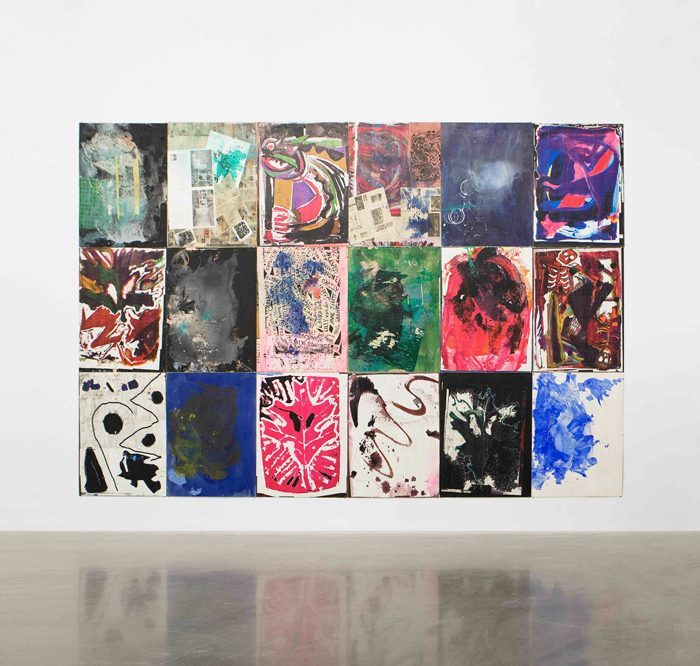
Josh Smith, Large Collage (New Museum), 2009. 18 mixed media collages on panel, 60 x 48 inches each. Courtesy of the artist and Luhring Augustine, New York. Photo: Benoit Pailley.
The relationality that I’m claiming for the Younger than Jesus work contributes to the impression that this work takes Ranciere’s model of spectatorship as a given. Dominique Gonzalez-Foerster, who is more closely associated with earlier relational practices, echoes Ranciere but, connecting the “scrambling of boundaries between consumption and production” to equality, she includes the artist in the equation: “Even if it is illusory and utopian, what matters is introducing a sort of equality, assuming the same capacities, the possibility of an equal relationship, between me… and others, allowing them to organize their own story in response to what they have just seen, with their own references.”43 Josh Smith, one of the Younger than Jesus artists, makes a similar claim for the artworks themselves. Talking about his paintings, which he creates “in bulk,” he says, “I stack them up because I really love them all. It’s the idea of equality.”44 Arcangel, referring to the changes in the media landscape during the last couple of years, says, “[It’s] no longer a one-way street. It’s participatory. People just make things. And so I don’t know whether it’s so necessary to ‘reveal’ anything anymore.” The artwork, in other words, has stopped “wanting to emancipate us,” thereby emancipating us, the theory goes, in the process. But if criticality is in the eye of the beholder, its transcendence of conventionality comes at the cost of its cultural value. In which case, we’re likely to end up with something like iArt. The question isn’t whether it’s art, but whether it needs to be. Why hold onto the name if it no longer refers to something that has a cultural, and therefore shared, meaning?
Just as viewer activation, for Brecht, was an allegory for igniting the proletariat’s class consciousness, equality is not only a cornerstone of democracy but is also a signifier for it. Verification of the equality of intelligences is the catalyst for the empowerment that’s needed to seize liberty, that is, for subjects to emancipate themselves instead of being (passively) emancipated. “Liberty,” writes Ranciere, “is not guaranteed by any pre- established harmony. It is taken, it is won, it is lost, solely by each person’s effort.”45 But this hypothesis assumes a kind of pre-ideological or ideologically innocent subject. Laura Mulvey, pondering whether it was possible to formulate a feminist critique that employed psychoanalytic theory, asked, “how to fight the unconscious structured like a language…while still caught within the language of patriarchy?”46 By contrast, Ranciere, whose experience of May 1968 led to his break with Louis Althusser, seems unconvinced by the latter’s argument that, “there are no subjects except by and for subjection” and, as a result, the agency with which Ranciere’s subject is endowed is free of the implications of this conclusion.47 Ranciere’s critique of consensus, then, seems to discount ideology’s “recruitment” of subjects–that is, the ideological transformation of individuals into (subjected) subjects.
Ranciere’s focus on individuality resonates with the business model known as the Long Tail, which Chris Anderson, the editor of Wired magazine, identified several years ago. The Long Tail describes the shape of a graph that illustrates how booksellers, for instance, can do just as well selling a single copy of many different books as they can selling many copies of a single title. “Long Tail business,” writes Anderson, “can treat consumers as individuals, offering mass customization as an alternative to mass-market fare.”48 For Anderson, this model ends the “tyranny of the hit,” opening up the market–and culture–to a more diverse range of offerings, eliminating, or at least reducing, the dominance of the lowest-common-denominator blockbuster. According to Anderson, we are becoming a “niche nation, defined not by our geography but by our interests. Instead of the weak connections of the office water cooler, we’re increasingly forming our own tribes, groups bound together more by affinity and shared interests than by broadcast schedules. These days our water coolers are increasingly virtual–there are many different ones, and the people who gather around them are self-selected.”49
Arcangel predicts that art, like everything else, will become more and more specialized, if for no other reason than that the system has made it possible. “[T]here won’t be mixing even within popular culture simply because of the way information travels,” he says, echoing Anderson. “Each person goes his or her own way. Already, we don’t have superstars like Michael Jackson anymore, because people aren’t ‘watching the same channel.'” This means that there is an audience, albeit microscopic in some cases, for everything, no matter how obscure or specialized–which means that as far as art is concerned there can, as he says, “never be a wrong move.” The “improved” apparatus that Benjamin envisioned as a result of its dialectical transformation (which included transcending the “specialization in the process of production”) has, in the absence of that transformation, become the “new and improved” apparatus of global capitalism in which collaboration between producers and consumers just makes more specialized–i.e. better–consumers. The equality of specialized consumers is not just tolerated, it’s fostered by this apparatus, since the “improvement” of consumers maintains the status quo, or “improves” it by further entrenching it. If millions of people engaged in dissensus, each with a different understanding of what that means, it might indeed spell the end of consensus (the “tyranny of the hit”). But at what cost, since without common cause dissensus can only be raised to the power of one?
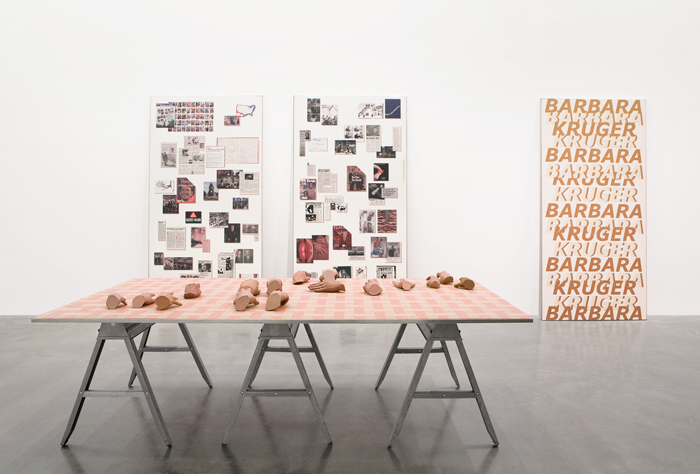
Matt Keegan, 1986/2008 New Museum Edit, 2009. Installation includes AMERICAMERICA (2008) excerpts, 23 Portraits of 22 year-olds (2008), Barbara Kruger (2008), and Hands Almost Across America (2008). Sheetrock, inkjet prints, 23 framed digital chromogenic prints, hydrocal, latex paint, and acrylic; dimensions variable. Courtesy the artist and d’Amelio Terras, New York. Photo: Benoit Pailley.
Perhaps, as Donald Judd wrote about art’s shift to actual, as opposed to illusionistic, space, it will turn out that virtual space is just “a space to move into.”50 But the impact that developments in social media are starting to have on art practice raises a number of questions that seem worth considering: Will art continue to serve a cultural function? Or will it be dedifferentiated, making it invisible (as art) or visible only as “professional art”? Is equality the new quality?
Mary Leclere is Associate Director of the Core Program at the Museum of Fine Arts, Houston.
